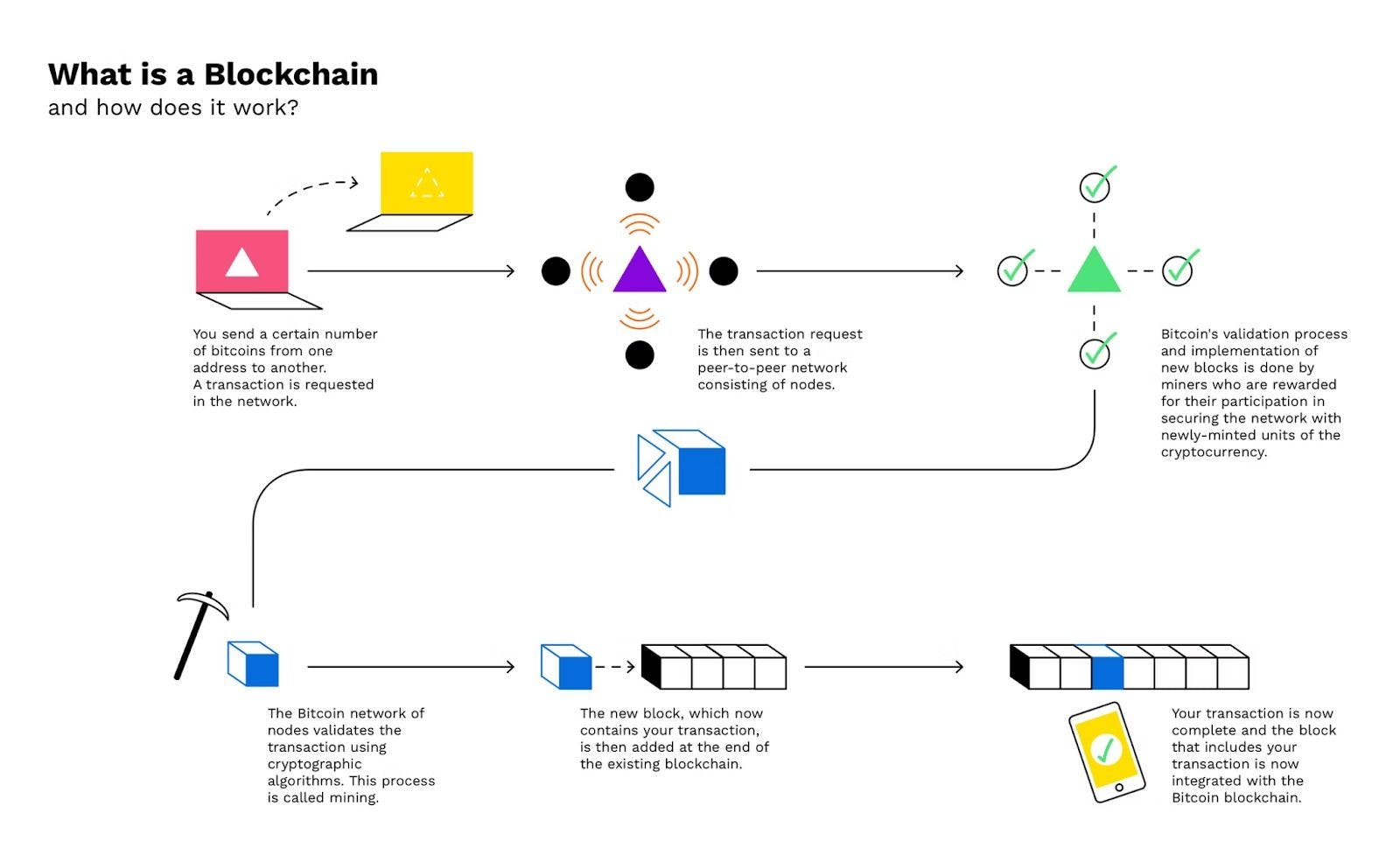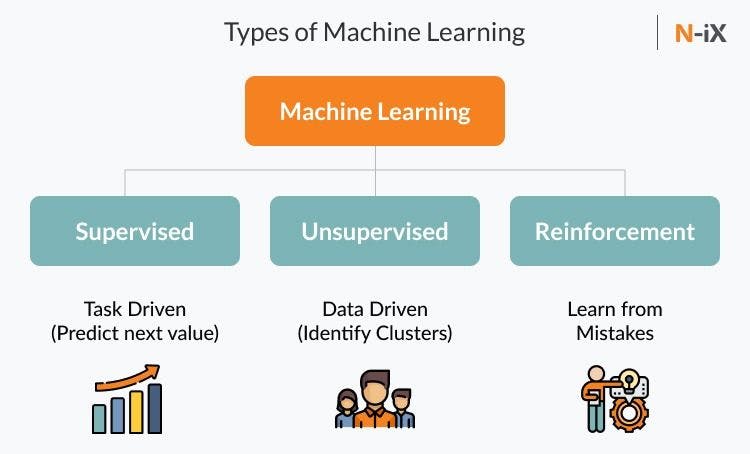Combining Machine Learning With Blockchain and Its Outcome
•5 min read
- Languages, frameworks, tools, and trends

Among the most disruptive technologies of the 21st century, machine learning (ML) and blockchain definitely come out on top. Individually, they greatly benefit businesses and sectors. Machine learning, with its algorithms and modeling, is doing wonders for predictions while blockchain is enabling secure financial transactions as well as use cases to become decentralized. But, what if these two game-changing technologies were to be combined? What results could we expect?
This article will examine these questions and the possible ways they can be combined. Note that a basic understanding of machine learning and blockchain is needed.
The workings of Blockchain
Below is a simple diagram that shows how a blockchain works:

Image source: bitpanda.com
The diagram is self-explanatory, but let’s look at some key features of blockchain technology.
- It is a distributed database shared amongst the nodes in a computer network.
- It is a decentralized technology that does not have any governing authority. A group of nodes maintains the network.
- It provides security and transparency.
- It follows a proof-of-work consensus algorithm and, hence, all transactions are approved and verified on the network.
- Blockchain technology is widely used in cybersecurity, anti-money laundering tracking systems, banking, etc.
The mechanics of Machine Learning
Here’s a quick look at the main training models of machine learning.

Image source: nix.com
Machine learning finds application in a number of fields, thanks to its adaptability and accuracy.
- There are three main ML training methods: supervised learning, unsupervised learning, and semi-supervised learning.
- ML uses data to find patterns and perform predictions to solve problems.
- The data used to make ML models can be of any type including text, numeral, audio, image, video, etc.
- Some real-world ML use cases are speech recognition, customer service, computer vision, recommendation engines, etc.
How Machine Learning and Blockchain can be combined
Machine learning needs data to create models and make predictions from the patterns it identifies. Meanwhile, blockchain can efficiently store data in a very secure manner. This means that the powers of both technologies can be harnessed to develop innovative solutions. There are some sectors that are already using them in an integrated manner. Here’s how:
Education
Applying machine learning and blockchain to the education sector can do wonders. Student data can be stored on the blockchain to provide universities with an official decentralized database of students who have studied there. Machine learning models can then predict future job roles for students after their higher studies. If trained properly, ML models can also be used to predict valid data. This whole system can also be used by employers to verify the educational records of their employees. Sort of like an e-portfolio.
Product manufacturing
In organizations where transparency, security, and other compliance checks are crucial, blockchain-based procedures are very helpful. Along with these, machine learning can be used to check when maintenance is required, automatically maintain quality levels, and be utilized for product testing. Both technologies can contribute plenty towards automating product manufacture.
Financial services
Machine learning with blockchain is already drastically transforming the finance sector by enabling smooth services. Transaction speeds, multi-party transactions, loan processes, etc. have accelerated and it’s thanks to these disruptive technologies.
User data is stored on the blockchain for security. Machine learning algorithms work on it to provide faster services, evaluate customer applications, and check for any fraud or risk, hence, ensuring overall improvement in the customer service level.
Surveillance systems
Blockchain can be used to manage continuous data. Meanwhile, machine learning can work on the same to perform analysis and make predictions to assist surveillance activities.
Healthcare
Machine learning and blockchain have made significant impacts in the healthcare sector. Patient data and health records are stored on the blockchain to protect privacy, while ML algorithms and models work on the data to extract valuable insights. These insights help doctors identify patterns, track disease transmission, and enhance treatment methodology.
Benefits of combining ML and Blockchain
The fusion of machine learning and blockchain technology has already transformed sectors. Major industries like manufacturing, healthcare, logistics, energy, etc. have benefited greatly and more continue to be.
1. Better security and enhanced transparency
Blockchain’s hallmark is that it’s highly secure because data is stored in blocks and then sealed using cryptographic algorithms, which makes data manipulation nigh impossible. Small wonder that blockchain is considered perfect for storing highly sensitive data, for e.g., medical-related data, personalized recommendations, etc. On the other hand, machine learning helps deploy blockchain applications and predicts possibilities of system breaches. Together, they enhance security and transparency.
2. Lower maintenance cost
Combining machine learning and blockchain can be very useful for small-scale companies that cannot afford high maintenance costs. Schedulers for maintenance can be set up on the blockchain so that everyone is responsible for their particular tasks. Machine learning can help predict the exact timings to carry out maintenance depending upon collected data and data analysis techniques.
3. Reduction in energy usage
Blockchain technology requires heavy computing power for data centers and cryptocurrency mining because it employs high-end CPUs and GPUs. However, machine learning can help reduce this power consumption. Case in point: Google successfully used machine learning to decrease energy usage in data centers, reducing approximately 35% of energy needs.
4. Data management
Blockchains are used to store information in the form of digital ledgers, and machine learning can predict possible breaches of data, thereby helping enhance data management.
Is merging these two technologies really helpful for the future?
As you know, there are huge disruptions taking place in the financial sector owing to blockchain technology as it removes all middlemen from business transactions. It’s, therefore, not difficult to imagine what the future will be like when machine learning is thoroughly integrated with blockchain, not just in finance but across sectors. From making blockchain smarter and more secure to maximizing RoIs and improving efficiency, the coming years look bright.
Blockchain is a ledger of continuously growing data and machine learning requires massive volumes of data. Both technologies complement each other, which is why they have the potential to usher in exciting digital transformations.